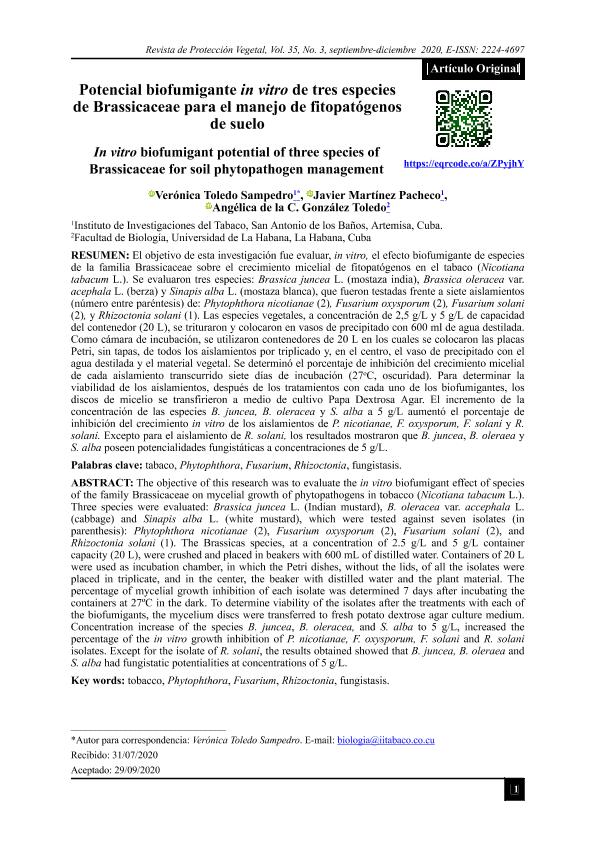Mostrar el registro sencillo del ítem
dc.contributor.author
Toledo Sampedro, Verónica
dc.contributor.author
Martinez Pacheco, Javier

dc.contributor.author
González Toledo, Angélica de la C.
dc.date.available
2021-09-03T12:25:36Z
dc.date.issued
2020-12
dc.identifier.citation
Toledo Sampedro, Verónica; Martinez Pacheco, Javier; González Toledo, Angélica de la C.; Potencial biofumigante in vitro de tres especies de Brassicaceae para el manejo de fitopatógenos de suelo; Centro Nacional de Sanidad Agropecuaria; Revista de Proteccion Vegetal; 35; 3; 12-2020; 1-8
dc.identifier.uri
http://hdl.handle.net/11336/139605
dc.description.abstract
El objetivo de esta investigación fue evaluar, in vitro, el efecto biofumigante de especiesde la familia Brassicaceae sobre el crecimiento micelial de fitopatógenos en el tabaco (Nicotianatabacum L.). Se evaluaron tres especies: Brassica juncea L. (mostaza india), Brassica oleracea var.acephala L. (berza) y Sinapis alba L. (mostaza blanca), que fueron testadas frente a siete aislamientos(número entre paréntesis) de: Phytophthora nicotianae (2), Fusarium oxysporum (2), Fusarium solani(2), y Rhizoctonia solani (1). Las especies vegetales, a concentración de 2,5 g/L y 5 g/L de capacidaddel contenedor (20 L), se trituraron y colocaron en vasos de precipitado con 600 ml de agua destilada.Como cámara de incubación, se utilizaron contenedores de 20 L en los cuales se colocaron las placasPetri, sin tapas, de todos los aislamientos por triplicado y, en el centro, el vaso de precipitado con elagua destilada y el material vegetal. Se determinó el porcentaje de inhibición del crecimiento micelialde cada aislamiento transcurrido siete días de incubación (27oC, oscuridad). Para determinar laviabilidad de los aislamientos, después de los tratamientos con cada uno de los biofumigantes, losdiscos de micelio se transfirieron a medio de cultivo Papa Dextrosa Agar. El incremento de laconcentración de las especies B. juncea, B. oleracea y S. alba a 5 g/L aumentó el porcentaje deinhibición del crecimiento in vitro de los aislamientos de P. nicotianae, F. oxysporum, F. solani y R.solani. Excepto para el aislamiento de R. solani, los resultados mostraron que B. juncea, B. oleraea yS. alba poseen potencialidades fungistáticas a concentraciones de 5 g/L.
dc.description.abstract
The objective of this research was to evaluate the in vitro biofumigant effect of species of the family Brassicaceae on mycelial growth of phytopathogens in tobacco (Nicotiana tabacum L.). Three species were evaluated: Brassica juncea L. (Indian mustard), B. oleracea var. accephala L. (cabbage) and Sinapis alba L. (white mustard), which were tested against seven isolates (in parenthesis): Phytophthora nicotianae (2), Fusarium oxysporum (2), Fusarium solani (2), and Rhizoctonia solani (1). The Brassicas species, at a concentration of 2.5 g/L and 5 g/L container capacity (20 L), were crushed and placed in beakers with 600 mL of distilled water. Containers of 20 L were used as incubation chamber, in which the Petri dishes, without the lids, of all the isolates were placed in triplicate, and in the center, the beaker with distilled water and the plant material. The percentage of mycelial growth inhibition of each isolate was determined 7 days after incubating the containers at 27ºC in the dark. To determine viability of the isolates after the treatments with each of the biofumigants, the mycelium discs were transferred to fresh potato dextrose agar culture medium. Concentration increase of the species B. juncea, B. oleracea, and S. alba to 5 g/L, increased the percentage of the in vitro growth inhibition of P. nicotianae, F. oxysporum, F. solani and R. solani isolates. Except for the isolate of R. solani, the results obtained showed that B. juncea, B. oleraea and S. alba had fungistatic potentialities at concentrations of 5 g/L.
dc.format
application/pdf
dc.language.iso
spa
dc.publisher
Centro Nacional de Sanidad Agropecuaria
dc.rights
info:eu-repo/semantics/openAccess
dc.rights.uri
https://creativecommons.org/licenses/by-nc-sa/2.5/ar/
dc.subject
Tabaco
dc.subject
Phytophthora
dc.subject
Fusarium
dc.subject
Rhizoctonia
dc.subject
fungistasis
dc.subject.classification
Micología

dc.subject.classification
Ciencias Biológicas

dc.subject.classification
CIENCIAS NATURALES Y EXACTAS

dc.title
Potencial biofumigante in vitro de tres especies de Brassicaceae para el manejo de fitopatógenos de suelo
dc.title
In vitro biofumigant potential of three species of Brassicaceae for soil phytopathogen management
dc.type
info:eu-repo/semantics/article
dc.type
info:ar-repo/semantics/artículo
dc.type
info:eu-repo/semantics/publishedVersion
dc.date.updated
2021-08-20T19:37:39Z
dc.identifier.eissn
2224-4697
dc.journal.volume
35
dc.journal.number
3
dc.journal.pagination
1-8
dc.journal.pais
Cuba

dc.journal.ciudad
Mayabeque
dc.description.fil
Fil: Toledo Sampedro, Verónica. Instituto de Investigaciones del Tabaco; Cuba
dc.description.fil
Fil: Martinez Pacheco, Javier. Consejo Nacional de Investigaciones Científicas y Técnicas. Oficina de Coordinación Administrativa Parque Centenario. Instituto de Investigaciones Bioquímicas de Buenos Aires. Fundación Instituto Leloir. Instituto de Investigaciones Bioquímicas de Buenos Aires; Argentina
dc.description.fil
Fil: González Toledo, Angélica de la C.. Universidad de la Habana. Facultad de Biología; Cuba
dc.journal.title
Revista de Proteccion Vegetal
dc.relation.alternativeid
info:eu-repo/semantics/altIdentifier/url/http://revistas.censa.edu.cu/index.php/RPV/article/view/1099
Archivos asociados
